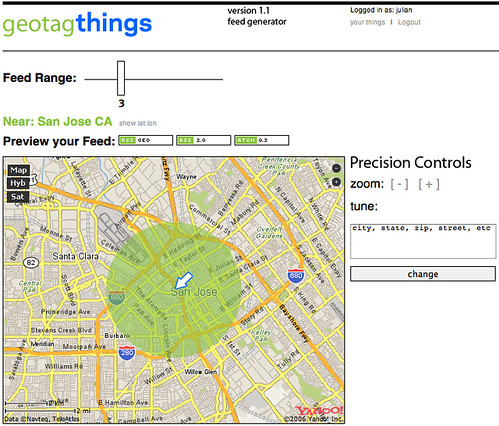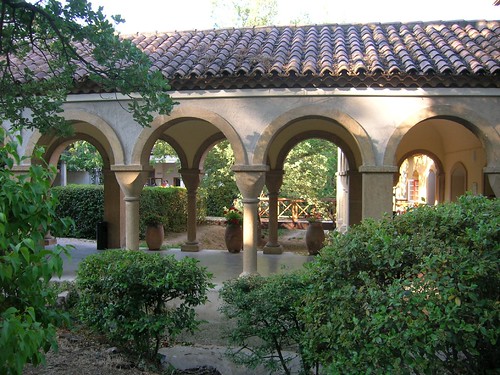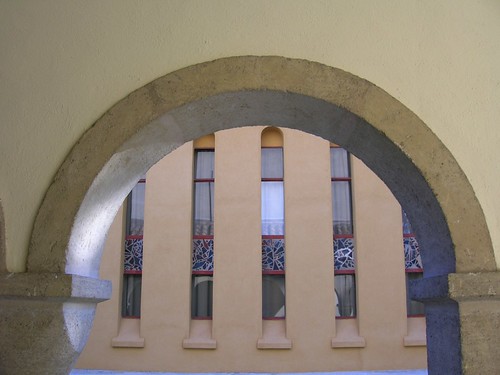(sorry bad english below, I took notes in real time and recomposed them quickly)
As I mentionned earlier, I had to manage a workshop about "locative media" and spatial technology today. What was interesting is that attendants had quite different ideas in mind when attending it: some were concerned by business models, other by memories in space, one or two by a curiosity towards google earth, place-based annotations, others by mobility and technology. Maybe the description on the website was a bit too narrow: since it quoted google earth, yellow arrow or flickr, different representation has been triggered in people's mind.
After introducing the whole concept and describing the fact that it is a bit messy and cover lots of practices/technologies/services/usage; there was thre presentations. The first one by Yann Le Fichant who is leading a company called voxinzebox; he explained us the different services they propose for city navigation (first on 2nd generation GSM and now on on pocketPC). He recalled us the importance of self-geolocation in that context (people declaring their own location on a cell phone to get some information about a specific place that would eventually guide them to various landmarks). He also underlined the importance of PND (personal navigation display) like TomTom or garmin that are more and more complex (improved memory, communication protocol) and could lead to new innovative tools. Yann provocatively asked why the sex industry has not yet found any big hits using location-based applications. The discussion also led Google's move in the 3D modeling by buying sketch-up (a modeling tool that would eventually allow people to model their house in 3D and put in on a google map)
Then Cyril Burger talked about his PhD research: an ethngraphy of the usage of mobile phones in the parisian subway. Cyril investigated people's behaviro and trajectory while using audio-communication and SMS. He underlined the fact that the transport facility first did not introduce any norms: so the rules that emerge were based on another norm based on how people drive. Through that code, rules of sociability emerged in terms of movements (for instance stopping in location which are not crowded so that the flow is not cut, the arrival of the metro often lead the user to stop the conversation). In terms of gesture, people stay often inanimated while texting, whereas audicommunication leads to more active/lively behavior (gestures, smiles...).
I also like his remark about the very fact that non-material places needed material places: servers need to be located somewhere. This is connected to what Jeffrey Huang talked about at LIFT06: the fact that networked technologies leads to new sort of places (and subsequently that place still matter).
Then Georges Amar (foresight manager at RATP, a subway company in france) presented the new paradigm of his company. Subway companies previously based their development on hygienist theories: efficiency was correlated with fluidity and less contact as possible (which is nicely exemplified by the non-contact RFID subway passes): the subway was disconnected with the city. Automation lead to layoff and the disappearance of controllers and even drivers, this caused the permeability of the subway (more and more insecurity, people taking it without paying): the city entered the subway. Now their model is rather about having both efficiency AND contact: let's take advantage of the presence of people, the city is in the metro and there are opportunities to have relevant services. The crowd is seen as a resource and not as a constraint. In terms of prospective services, places/stations can be transformed, new type of jobs can be created and tansporters' role change accordingly. The subway could then be seen as a PLACE to meet people, or at least to do something with others. One of the attendant mentionned the idea Starbucks had to be a place for business meetings: would the subway have certain area for business meetings? Another point is the signs that are fixed and directed to every users could be individualized for a certain category of customers (with precise interests or disabilities) or even further: the crowd's traces in space would be a material to use to create new kind of signs to foster better navigation or discovery of places or people.
After those 3 presentations, we had a discussion about different projects (current or prospective) like earthTV (seeing real-time events with google earth, this has actually been thought in the japanese subway to see where is the crowd to better avoid it), tags in google earth (very often community-based "I use linux" close to MS buidling), locator of personal objects (googling my shoes, finding my personal belongings), indoor technologies (museum), trackers (kids/prisoner tracking).
Overall, the discussion rather revolved around mobility, people and a lot about meetings, and less about technologies and usage. That's important from the rhetorical point of view: we rather dicussed the contexts and the needs (with a peculiar emphasis on the subway experience) as opposed to the technology-push projects we've seen so far: allowing PEOPLE (with a specific context: mobility, limited amount of time, limited cognitive resources because of route finding) to do something (having meetings and exchange with others, discovering information related or not to the route).
One of the conclusions here was also that innovation in spatial technologies is often due to work of peculiar companies such as RATP (subway companies), JCDecaux (urban ads) which are ubiquitous and bound to specific mobile needs. Soome researchers from a french phone operator acknowledged the fact that innovation is very tough for them because everything is either locked or behind walled gardens when it comes to phone (SIM cards, low interoperability, different standards, hard to use voice / location based application, different kind of phones/handhelds...). This resonates with discussions we had at the lab (see here or there).
Technorati Tags: upfing, upfing06












